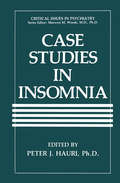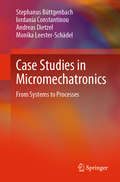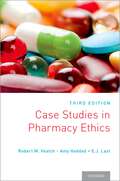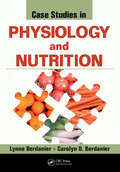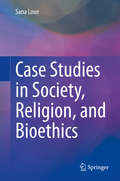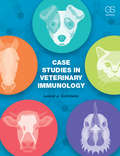- Table View
- List View
Case Studies in Insomnia (Critical Issues in Psychiatry)
by Peter J. HauriIf ever a book could be called timely, this is it. Sleep disorders medicine has made rapid advances in recent years. The field has attained growing respectability, with a textbook recently published, a congressionally man dated National Commission on Sleep Disorders Research, and a growing public awareness of the importance of sleep disorders. However, this rapid growth has made the discrepancy among certain components of the field all the more obvious. Thus, we find that patients who complain of insom nia are almost never in the majority of those seen in sleep disorders centers, in spite of the well-known fact that the prevalence of such individ uals in our society is by far the largest. Current articles on insomnia abound, but they tend to be facile recitations of diagnosis and impractical global recommendations for treat ment, without providing the essential details. Indeed, the clinical profes sions really do not know what to do about insomnia. This is reflected in a number of observations I have made in the recent past. For example, the majority of individuals who complain of insomnia take alcohol, aspirin, over-the-counter medications, hot baths, and a host of other nostrums, but rarely seek a physician. In the unlikely event that a physician is consulted, he is likely to prescribe a sleep medication but without any particular consistency, or any clear instructions on its use.
Case Studies in Lipid Management
by D. John BetteridgeJohn Betteridge, Professor of Medicine at the Middlesex Hospital in London is one of the world's leading lipidologists and diabetologists. Professor Betteridge has bought together a definitive collection of 35 study cases written by opinion leaders in the field of lipid management. Each case is a highly informative study based on each contributor's
Case Studies in LPN/LVN Nursing E-Book
by Janis McMillanGain valuable experience applying your knowledge and critical thinking skills to real-world scenarios! Case Studies in LPN/LVN Nursing features 50 case studies that cover all clinical areas of practice: fundamental skills, medical-surgical adult health nursing, pediatric, maternity, mental health, geriatric nursing, and leadership management. Patient scenarios help you learn how to apply nursing knowledge to nursing practice by promoting the development of critical thinking and clinical reasoning skills. Cases integrate content on assessment findings, diagnostic/laboratory tests, pharmacology, and nutrition to encourage you to think critically about all aspects of patient care, including the physical and psychosocial needs of the patient, communication, collaboration with the health care team, teaching wellness and health promotion, and integration of cultural competence. Cases unfold as care is provided and a variety of multiple-choice, select-all-that-apply, prioritization, and short-answer questions challenge you to formulate and select relevant and/or potential decisions. The case studies are separated by clinical area, allowing you to use this worktext throughout your nursing program. Questions for the Next-Generation NCLEX® (NGN) prepare you for the biggest change to the NCLEX-PN® test plan to date.Fifty case studies cover patient scenarios that span the entire LPN/LVN curriculum.Unfolding case progressions help you learn to identify changes, anticipate outcomes, and prioritize care.Emphasis on interprofessional collaboration builds your communication and delegation skills.A variety of question formats reinforce critical thinking and help you prepare for the NCLEX-PN® exam.Documentation questions challenge you to identify critical information to chart.
Case Studies in Medical Toxicology: From the American College of Medical Toxicology
by Leslie R. Dye Christine Murphy Diane P. Calello Michael D. Levine Aaron SkolnikThe ACMT National Case Conference (NCC) is a monthly discussion of novel or interesting cases in medical toxicology. Participation is through online webinar, and the conferences are recorded to allow for review at any time. The cases in this book are taken from recordings of NCC with edits and revisions by contributors and editors to demonstrate educational points. The majority of the case information is from the original recording and represents actual patient presentations. However, some of the details have been changed and fictional information added to enhance the educational value. This volume covers a broad range of toxicological topics, and specialty guidance is offered at the end of every case to aid non-toxicologists. The dilemmas are applicable to both academic and clinical medicine. A list of relevant questions is also provided for each case. Subjects include common toxicological problems, rare presentations of common problems, common problems with controversial treatments or difficult diagnoses, and rare problems.Case Studies in Medical Toxicology from the American College of Medical Toxicology is a detailed reference text on specific toxicological issues and also serves as a practical review for those taking board exams. As a result, this volume is an important and necessary resource for medical students, residents, and fellows, as well as primary-care physicians, intensivists, and toxicologistsCase Studies in Medical Toxicology from the American College of Medical Toxicology is a detailed reference text on specific toxicological issues and also serves as a practical review for those taking board exams. As a result, this volume is an important and necessary resource for medical students, residents, and fellows, as well as primary-care physicians, intensivists, and toxicologists. All proceeds from this book will be donated to the Medical Toxicology Foundation.
Case Studies in Micromechatronics: From Systems to Processes
by Stephanus Büttgenbach Iordania Constantinou Andreas Dietzel Monika Leester-SchädelThe book “Case Studies in Micromechatronics – From Systems to Process” offers prominent sample applications of micromechatronic systems and the enabling fabrication technologies. The chosen examples represent five main fields of application: consumer electronics (pressure sensor), mobility and navigation (acceleration sensor), handling technology and automation (micro gripper), laboratory diagnostics (point of care system), and biomedical technology (smart skin). These five sample systems are made from different materials requiring a large variety of modern fabrication methods and design rules, which are explained in detail. As a result, an inverted introduction “from prominent applications to base technologies” is provided. Examples of applications are selected to offer a broad overview of the development environment of micromechatronic systems including established as well as cutting-edge microfabrication technologies.
Case Studies in Modern Drug Discovery and Development
by Xianhai Huang Robert G. AslanianLearn why some drug discovery and development efforts succeed . . . and others fail Written by international experts in drug discovery and development, this book sets forth carefully researched and analyzed case studies of both successful and failed drug discovery and development efforts, enabling medicinal chemists and pharmaceutical scientists to learn from actual examples. Each case study focuses on a particular drug and therapeutic target, guiding readers through the drug discovery and development process, including drug design rationale, structure-activity relationships, pharmacology, drug metabolism, biology, and clinical studies. Case Studies in Modern Drug Discovery and Development begins with an introductory chapter that puts into perspective the underlying issues facing the pharmaceutical industry and provides insight into future research opportunities. Next, there are fourteen detailed case studies, examining: All phases of drug discovery and development from initial idea to commercialization Some of today's most important and life-saving medications Drugs designed for different therapeutic areas such as cardiovascular disease, infection, inflammation, cancer, metabolic syndrome, and allergies Examples of prodrugs and inhaled drugs Reasons why certain drugs failed to advance to market despite major research investments Each chapter ends with a list of references leading to the primary literature. There are also plenty of tables and illustrations to help readers fully understand key concepts, processes, and technologies. Improving the success rate of the drug discovery and development process is paramount to the pharmaceutical industry. With this book as their guide, readers can learn from both successful and unsuccessful efforts in order to apply tested and proven science and technologies that increase the probability of success for new drug discovery and development projects.
Case Studies in Modern Drug Discovery and Development
by Xianhai Huang Robert G. AslanianLearn why some drug discovery and development efforts succeed . . . and others fail Written by international experts in drug discovery and development, this book sets forth carefully researched and analyzed case studies of both successful and failed drug discovery and development efforts, enabling medicinal chemists and pharmaceutical scientists to learn from actual examples. Each case study focuses on a particular drug and therapeutic target, guiding readers through the drug discovery and development process, including drug design rationale, structure-activity relationships, pharmacology, drug metabolism, biology, and clinical studies. Case Studies in Modern Drug Discovery and Development begins with an introductory chapter that puts into perspective the underlying issues facing the pharmaceutical industry and provides insight into future research opportunities. Next, there are fourteen detailed case studies, examining: All phases of drug discovery and development from initial idea to commercialization Some of today's most important and life-saving medications Drugs designed for different therapeutic areas such as cardiovascular disease, infection, inflammation, cancer, metabolic syndrome, and allergies Examples of prodrugs and inhaled drugs Reasons why certain drugs failed to advance to market despite major research investments Each chapter ends with a list of references leading to the primary literature. There are also plenty of tables and illustrations to help readers fully understand key concepts, processes, and technologies. Improving the success rate of the drug discovery and development process is paramount to the pharmaceutical industry. With this book as their guide, readers can learn from both successful and unsuccessful efforts in order to apply tested and proven science and technologies that increase the probability of success for new drug discovery and development projects.
Case Studies in Multiple Sclerosis
by Paul S. GiacominiThis handbook is a collection of clinical narratives that underscore the heterogeneous and unpredictable presentation of multiple sclerosis (MS) and give real-world clinical context to recent drug developments. This accessible and concise publication is intended to be used by a wide range of medical professionals, from specialist neurologists to medical trainees with an interest in neurology. An ideal clinical resource, Case Studies in Multiple Sclerosis provides an evidence-based discussion of each case, with an aim to enhance effective diagnosis and treatment of patients with MS and MS-related conditions.
Case Studies in Nurse Anesthesia E-Book
by Sass ElishaClinical case studies make it easy to learn and master perioperative nurse anesthesia! Written in a succinct question-and-answer format, Case Studies in Nurse Anesthesia covers anesthesia management for the most frequently performed surgical procedures. Chapters are organized by surgical specialty, and each case describes the entire perioperative course of care, including the patient’s history, physical assessment, anesthetic considerations, surgical concerns, differential diagnosis, and potential complications. From noted anesthesia educator Sass Elisha, this reference will help you learn how to think like a highly skilled nurse anesthetist!Question-and-answer format provides an easy and engaging way to study the many aspects of perioperative anesthesia.55 case studies demonstrate a wide variety of diseases and surgeries, and allow readers to follow the thought process needed for successful nurse anesthesia practice.Preoperative, intraoperative, and postoperative perspectives are covered in the case studies and patient scenarios.Thorough discussions in each chapter include pathophysiology, pharmacology, surgical intervention, anesthesia case management, and postoperative considerations.Key points and preoperative evaluation notes are included at the beginning of each chapter, with review questions at the end.Expert author Sass Elisha is also the co-author of the popular text Nagelhout: Nurse Anesthesia.
Case Studies in Palliative and End-of-Life Care (Case Studies in Nursing #4)
by Margaret L. CampbellCase Studies in Palliative and End-of-Life Care uses a case-based approach to provide students and practitioners with an important learning tool to improve critical thinking skills and encourage discussion toward improving experiences for patients and their families. The book is organized into three sections covering subjects related to communication, symptom management, and family care. Each case is presented in a consistent, logical format for ease of use, highlighting key evidence-based concepts including the case history, care setting, diagnosis and prognosis, assessment, treatment considerations, and family support. A key reference, Case Studies in Palliative and End-of-Life Care is an invaluable resource for clinicians who provide palliative care to patients with life-limiting illnesses and those at the end of life along with their families.
Case Studies in Palliative and End-of-Life Care (Case Studies in Nursing)
by Margaret L. CampbellCase Studies in Palliative and End-of-Life Care uses a case-based approach to provide students and practitioners with an important learning tool to improve critical thinking skills and encourage discussion toward improving experiences for patients and their families. The book is organized into three sections covering subjects related to communication, symptom management, and family care. Each case is presented in a consistent, logical format for ease of use, highlighting key evidence-based concepts including the case history, care setting, diagnosis and prognosis, assessment, treatment considerations, and family support. A key reference, Case Studies in Palliative and End-of-Life Care is an invaluable resource for clinicians who provide palliative care to patients with life-limiting illnesses and those at the end of life along with their families.
Case Studies in Personalized Nutrition (Personalized Nutrition and Lifestyle Medicine for Healthcare Practitioners)
by Helen Lynam Lorraine Nicolle Miguel Toribio-Mateas Romilly Hodges Jo Gamble Elspeth Stewart Claire SehinsonThis edited collection gives practitioners the information they need to put their theoretical nutrition knowledge into practice, to help move their patient back towards health. It includes ten different case studies, case histories and answers to common questions.
Case Studies in Pharmacy Ethics: Third Edition
by Robert M. Veatch Amy Haddad E.J. LastPharmacists constantly face ethical choices -- sometimes dramatic matters of life-and-death decisions, but more often subtle, less conspicuous choices that are nonetheless important. Case Studies in Pharmacy Ethics identifies and discusses the broad range of ethics issues pharmacists confront in practice. Ranging from situations faced in direct patient care to broader issues, this book uses cases to explore topics and the ethical framework within which practitioners make decisions about such issues as assisted suicide, conscientious refusal, pain management, and confidentiality as well as the equitable distribution of drug resources within institutions or managed care organizations and clinical studies on vulnerable populations. As the scope of the pharmacist's role expands, pharmacists find themselves facing new ethical challenges. This third edition accounts for some of the many changes in pharmacy practice and in the delivery of health care since the second edition. It includes an entirely new chapter on health insurance and health system planning, and a discussion of the impact of the Affordable Care Act and cases that are updated to reflect current pharmacy practice models. It serves as a valuable resource regarding topics that are both specific to pharmacy practice and those that involve the health care system more generally.
Case Studies in Pharmacy Ethics: Third Edition
by Robert M. Veatch Amy Haddad E.J. LastPharmacists constantly face ethical choices -- sometimes dramatic matters of life-and-death decisions, but more often subtle, less conspicuous choices that are nonetheless important. Case Studies in Pharmacy Ethics identifies and discusses the broad range of ethics issues pharmacists confront in practice. Ranging from situations faced in direct patient care to broader issues, this book uses cases to explore topics and the ethical framework within which practitioners make decisions about such issues as assisted suicide, conscientious refusal, pain management, and confidentiality as well as the equitable distribution of drug resources within institutions or managed care organizations and clinical studies on vulnerable populations. As the scope of the pharmacist's role expands, pharmacists find themselves facing new ethical challenges. This third edition accounts for some of the many changes in pharmacy practice and in the delivery of health care since the second edition. It includes an entirely new chapter on health insurance and health system planning, and a discussion of the impact of the Affordable Care Act and cases that are updated to reflect current pharmacy practice models. It serves as a valuable resource regarding topics that are both specific to pharmacy practice and those that involve the health care system more generally.
Case Studies in Physiology and Nutrition
by Lynne BerdanierToday's knowledge of human health demands a multidisciplinary understanding of medically related sciences, and Case Studies in the Physiology of Nutrition answers the call. Dedicated to the integration of nutrition science with physiology, this text cohesively incorporates descriptions of human problems in order to stimulate students' critical thin
Case Studies in Primary Care - E-Book: A Day in the Office
by Joyce D. Cappiello Jeffrey A. Eaton Gene E. HarklessReal-world scenarios help you develop clinical reasoning skills for primary care! Case Studies in Primary Care: A Day in the Office, 2nd Edition includes 50 case studies on the most commonly encountered situations in primary care. Demonstrating the kinds of health problems that a Nurse Practitioner or Physician Assistant might see during a typical clinical day, case studies cover patients from various cultures and all ages. You’re asked to analyze data and think critically in reaching accurate diagnoses and planning effective treatment; you can then submit your responses online for grading and instant feedback. Real-world scenarios offer the opportunity to analyze clinical situations likely to be encountered in today's primary care settings, providing practice in clinical reasoning skills.Day in the Office format presents cases hour by hour, in the way a typical clinical day might unfold.Emphasis on problem-based learning helps you to think critically and analyze clinical situations — such as ear infections, diarrhea, and coughing and fever — in order to provide appropriate primary care. Six NEW cases are included (for a total of 50), with three focusing on older clients with more complex health challenges, one addressing unplanned pregnancy, and two addressing practice management issues.NEW! Emphasis on follow-up care addresses patients coming to the primary care setting from retail clinics, rehabilitation settings, or acute-care settings, and underscores the importance of interprofessional collaboration.NEW! Enhanced patient diversity includes cases for all age groups, and reflects a more contemporary appreciation of cultural diversity and gender/gender identity. NEW! Updates to all cases ensure that case studies and feedback are consistent with the latest research evidence, clinical practice guidelines, and national and international treatment standards.NEW! Online answer submission allows you to write Assessment and Plan answers in the printed book, then submit answers online for grading and feedback.NEW! Grading rubrics are provided on the companion Evolve website to help you develop your answers.NEW! Introduction explains how to get the most out of the book.
Case Studies in Public Health Nursing E-Book: Case Studies in Public Health Nursing E-Book
by Elsevier IncGain a better understanding of the nurse’s role in caring for populations and the community. The detailed scenarios in Case Studies in Public Nursing 1st Edition are real-life situations, designed to promote active learning, classroom discussions, and full comprehension of the material. Over 50 engaging scenarios are presented in a consistent format to help you quickly grasp topics such as community assessment, health promotion, and vulnerable populations. Featuring robust online content along with an accompanying user’s guide, these case studies are ideal for use in conjunction with a community health textbook. Plus, suggested readings corresponding to Elsevier community health textbooks are included to help foster a rich learning experience! NEW! More than 50 online, unfolding case studies bring community/public health nursing to life in order to help you understand how the role of the public health nurse fits into unique populations. NEW! Each case study is organized in a consistent format featuring objectives, unfolding case scenarios, gradable NCLEX®-style review questions, and open-ended critical thinking and discussion questions. NEW! Suggested readings from Elsevier community health textbooks (Nies, Stanhope, Edelman) are included so you can easily cross-reference relevant content. NEW! Answer guidelines are provided for all critical thinking and discussion questions. NEW! Helpful printed User’s Guide includes an overview of public health nursing, a full description of each case study, and instructions for using the product. NEW! A list of relevant Giddens concepts is provided for each case study. NEW! Each case study incorporates evidence-based practice and exemplifies public health nursing interventions from the Intervention Wheel. NEW! The Quad Council Coalition’s Community/Public Health Nursing Competencies provide the framework for the case studies, ensuring practice examples for each competency domain are included.
Case Studies in Society, Religion, and Bioethics: (pdf)
by Sana LoueThis book explores, through case studies, the interplay between religion, culture, government, and politics in diverse societies on questions arising in the domain of bioethics. The case studies draw from multiple disciplinary perspectives, including history, theology, law, bioethics, public policy, science, and medicine. The text's global perspective permits a comparison of the differing approaches adopted by countries facing similar bioethical quandaries and the extent to which religion has or has not been instrumental in addressing such dilemmas. Secular and religious societies across the globe are being confronted with complex questions involving religious belief and the extent to which specific religious perspectives have in the past or should in the future be adopted as official policy. Bioethical issues involving the interplay of religion and government have become particularly notable in recent years. How these issues are resolved has major implications for individuals, healthcare providers, and the future of medical research and medical care. Topics explored among the chapters include: Homosexuality: Sin, Crime, Pathology, Identity, BehaviorMedical Error: Truthtelling, Apology, and ForgivenessRefusal of Medical TreatmentMedical Deportation Case Study: Nazism, Religion, and Human ExperimentationThe New Frontier: Cloning Case Studies in Society, Religion, and Bioethics will find an engaged audience among researchers and scholars in history, religion/theology, medicine, and bioethics interested in the influence of religion on bioethical decision-making. Students—particularly upper-level undergraduate and graduate students interested in bioethics, humanities, and theology—will find the text helpful in understanding the processes through which religion may serve as a basis for both societal policy and law and individual decision-making in health-related matters.
Case Studies in Systemic Sclerosis
by Richard M. M. Silver and Christopher P. P. DentonCase Studies in Systemic Sclerosis deals specifically with Systemic Sclerosis in a case study format. Each case presentation includes illustrative figures, a discussion of the pathophysiology relevant to the case, a discussion of management that is both evidence-based and expert opinion-based and several key references for further reading. With its easy-to-use format, this book presents multiple different manifestations of Systemic Sclerosis to a wide range of readers. Because this disease has a broad range of systemic features, Case Studies in Systemic Sclerosis is a valuable reference tool not only to the community of rheumatologists (trainees, academic and private practice rheumatologists) and dermatologists, but also potentially to internists, gastroenterologists, pulmonologists, cardiologists and nephrologists.
Case Studies in Systems Biology
by Pavel KraikivskiThis book provides case studies that can be used in Systems Biology related classes. Each case study has the same structure which answers the following questions: What is the biological problem and why is it interesting? What are the relevant details with regard to cell physiology and molecular mechanisms? How are the details put together into a mathematical model? How is the model analyzed and simulated? What are the results of the model? How do they compare to the known facts of the cell physiology? Does the model make predictions? What can be done to extend the model? The book presents a summary of results and references to more relevant sources.The volume contains the classic collection of topics and studies that are well established yet novel in the systems biology field.
Case Studies in the Ethics of Assisted Reproduction
by Louise P. King Isabelle C. BandThis book evaluates some of the most common ethical issues confronted by reproductive endocrinologists, embryologists, and their teams. The authors apply core ethical principles and approaches to problem solving to each of the cases raised. This work is a guide for both those on the front lines of patient care as well as for students in the field, whatever their background. By outlining sample cases, the book is an instigator for ethical discussions among ethicists, medical practitioners and students.
Case Studies in Thyroid and Parathyroid Tumors
by Amit Agarwal Ranil Fernando Rajeev Parameswaran Anand Kumar Mishra Roma PradhanThe book covers all aspects of thyroid and parathyroid surgery, including history and examination, pre-operative workup, and how ancillary specialties like pathology, radiology, radiotherapy, and nuclear medicine impact the outcome of thyroid and parathyroid patients. It offers a step-by-step approach to help the readers manage their cases in their practice. It includes numerous color photographs, anatomical and operative line diagrams for easy understanding. Chapters include flow charts explaining the case management and the decision-making process. The book serves as a valuable resource to endocrine surgeons, general surgeons, endocrinologists, and internists. It also serves as reference material for the exit examination of masters of surgery and the super specialty entrance and exit exam for endocrine surgery. Additionally, it helps consultants and postgraduate students of radiology, pathology, nuclear medicine, and radiotherapy.
Case Studies in Veterinary Immunology
by Laurel GershwinCase Studies in Veterinary Immunology presents basic immunological concepts in the context of actual cases seen in clinics. It is intended for veterinary medicine students, interns, residents, and veterinarians, and serves as a valuable supplement and companion to a variety of core immunology textbooks and courses. The book includes cases describing primary immune system defects, secondary immune system defects, and hypersensitivity and autoimmune disorders, as well as dysproteinemias and lymphoid neoplasia. Drawing on the successful approach of Geha’s Case Studies in Immunology, each representative case is preceded by a discussion of the principles underlying that specific immunological mechanism. The case itself includes the presenting complaint (signalment), physical examination findings, pertinent diagnostic laboratory data, diagnosis, and treatment options. In those instances in which a specific disorder occurs in both animals and humans, the differences and similarities in the immunological mechanisms and manifestations of the disease are explored. End of case questions highlight important concepts and serve as a review aid for students. Details on standard vaccines and vaccination schedules, as well as descriptions of the types of assays used for evaluation of the immune system, are included as appendices.
Case Studies in Veterinary Immunology
by Laurel GershwinCase Studies in Veterinary Immunology presents basic immunological concepts in the context of actual cases seen in clinics. It is intended for veterinary medicine students, interns, residents, and veterinarians, and serves as a valuable supplement and companion to a variety of core immunology textbooks and courses. The book includes cases describing primary immune system defects, secondary immune system defects, and hypersensitivity and autoimmune disorders, as well as dysproteinemias and lymphoid neoplasia. Drawing on the successful approach of Geha’s Case Studies in Immunology, each representative case is preceded by a discussion of the principles underlying that specific immunological mechanism. The case itself includes the presenting complaint (signalment), physical examination findings, pertinent diagnostic laboratory data, diagnosis, and treatment options. In those instances in which a specific disorder occurs in both animals and humans, the differences and similarities in the immunological mechanisms and manifestations of the disease are explored. End of case questions highlight important concepts and serve as a review aid for students. Details on standard vaccines and vaccination schedules, as well as descriptions of the types of assays used for evaluation of the immune system, are included as appendices.
Case Studies of Near Misses in Clinical Anesthesia
by John G. Brock-Utne, MD, PhD, FFA(SA)All anesthesiologists eventually face the fear of a “near miss,” when a patient’s life has been put at risk. Learning from the experience is crucial to professionalism and the ongoing development of expertise. Drawing on forty-plus years of practice in major metropolitan hospitals in the United States, Norway, and South Africa, John Brock-Utne, MD presents 80 carefully selected cases that provide the basis for lessons and tips to prevent potential disaster. The cases emphasize problem-centered learning and span a broad range of topics—from an outbreak of operating room infection (could it be the anesthesia equipment?), complications of fiberoptic intubations, and problems with epidural drug pumps, to performing an urgent tracheostomy for the first time, working with an aggressive surgeon, and what to do when a patient falls off the operating table during surgery. 80 true-story clinical “near misses” never before published, ideal for problem-centered learning, recommendations, references, and discussions accompany most cases, rich basis for teaching discussions both in or out of the operating room, settings include sophisticated as well as rudimentary anesthetic environments, complements the author’s other case book, Clinical Anesthesia: Near Misses and Lessons Learned (Springer, 2008).
